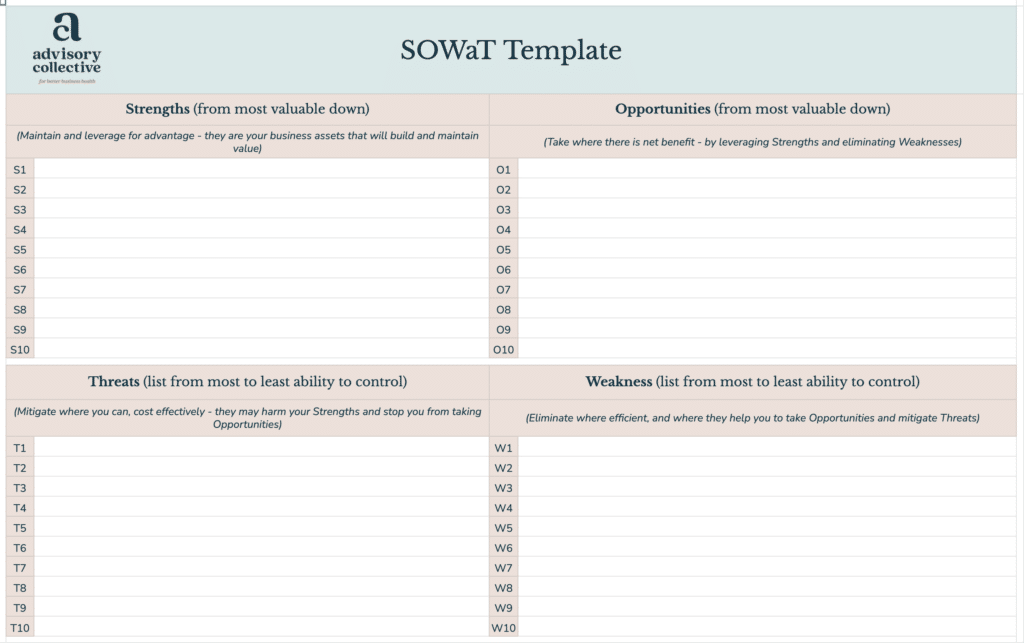Most people are familiar with “SWOT” exercises – where they list Strengths, Weaknesses, Opportunities and Threats – and many people have used them in their businesses, often in conjunction with strategic planning work or assessing and managing risks.
We think that SWOT-type work can be very useful, especially in small and medium sized businesses with limited capacity and capability to undertake more formal Risk Management processes. However, in our experience most SWOT exercises tend to stall – they don’t lead to lasting, positive change.
We think we know why that happens – and we have figured out how a small shift in your thinking (and the format of your SWOT analysis) can help you get the best out of this work, so that you can get full value for your risk management and strategic planning efforts.
How Acronyms Change Our Thinking and Actions
Most humans have a tendency to remember and act on verbal concepts that can be expressed as acronyms – but there are both advantages and disadvantages to their use.
While it’s true that acronyms can be efficient memory aids, you should never lose sight of the concepts that they are built on and reference. In business strategy and communications, acronyms are most useful when they remind us to think effectively about the fundamentals that they were built on, in a timely and agile way. They are least useful when they distort how we think and behave.
In the case of SWOT, what do we really mean by each letter, and what do we actually do with that knowledge ? Is the acronym helping or hurting us ?
The Weakness of W
We like starting SWOT analysis by reflecting on Strengths – it’s a positive and powerful approach. We always advise clients to play to their strengths, wherever possible – that’s how most of us succeed, after all.
The big problem with “SWOT” is the negative and even paralysing nature of Weaknesses:
- When we think about our Weaknesses, we often become despondent and less motivated to act.
- Many of us struggle to act on our Weaknesses – we may not be able to “fix” them, but we feel guilty if we don’t try.
- Perhaps worst of all, many of us would prefer to avoid thinking about Weaknesses altogether – whether they are within us, or within our businesses.
So it’s no surprise that many SWOT exercises fall over at the “W point”, even before we move on to Opportunities and Threats.
Start Out Positive
If Strengths are the “existing assets” of our businesses, Opportunities are our “future assets”. They are our ambitions and dreams that we can seize or make real, by deploying our Strengths (while managing our Weaknesses and Threats where necessary – I will come back to that later).
If we focus on Opportunities right after our Strengths, then we are thinking positively about what we can do that will create more value over time. That gives us positive momentum – and powerful reasons to keep going when we do have to deal with less attractive issues.
Once we have confirmed that we have real Strengths and valuable Opportunities, we know its worthwhile engaging with our Weaknesses and Threats.
Weaknesses vs Threats
Fortified by our Strengths and Opportunities, we can now be resolute about our Weaknesses and Threats. Collectively, they are the risks of our businesses, and it’s better that we know about them and act appropriately, rather than ignore them, because they may dissipate our Strengths and prevent us from taking our Opportunities.
But how are they different? We distinguish between them based on where they are found. Essentially, an “internal risk” is a Weakness, and an “external risk” is a Threat. It’s important we distinguish between them, because we can’t assess or act on them if we don’t know where to find them.
Sometimes it’s easier to deal with a Weakness, because we are working on ourselves and our own businesses, whereas many Threats are beyond our control or even influence. That’s why we still put “W” before “T”, in SOWaT.
You Don’t Have to Fix Everything – Prioritise !
As I’ve already noted, it’s much easier to play to Strengths when seizing Opportunities – and they can also be used to minimise Weaknesses and mitigate Threats. But don’t waste your Strengths – for example, there is no point spending $10,000 to deal with a Weakness that might only ever cost your business $5,000 in losses.
Its perfectly fine to identify a Weakness or a Threat and decide to do nothing, if the costs of prevention or rectification are objectively too high. And remember that time has value just like money, in any business – it can often take a lot of work to fix a Weakness, or head off a Threat. We would often be better off putting that work into our Opportunities.
“So What ?”
Let’s bring it all together, using our “SOWaT” methodology:
- Always start with Strengths – maintained and leveraged for advantage, they are our business assets that will build and maintain value.
- Move on to Opportunities – seize where there is net benefit, by leveraging our Strengths, minimising Weaknesses and mitigating Threats.
- Assess Weaknesses – but only minimise where efficient.
- Assess Threats – but only mitigate where efficient.
Here’s how we format a SOWaT analysis when we work with our clients:

But How Will I Know ?
We may be close to our businesses, but we may not be clear about their SOWaT profile. We can exaggerate Strengths, we can lack confidence about Opportunities, we often avoid even thinking about Weaknesses, and we can ignore scary Threats that are absolutely predictable – in hindsight.
In our private lives, our friends will remind us of our Strengths, our mentors might suggest Opportunities, our spouses will remind us of our Weaknesses during an argument and our doctors will warn us about Threats.
This is one of the reasons why we created our Business Health Check – so that business owners like you have the clarity and confidence to complete your SOWaT well, get your strategy right and make your businesses more profitable, healthier and more valuable. After all, its better to know where you and your business really stands, rather than just hoping everything is OK.
So I’ve Got My SOWaT – Now What ?
As mentioned earlier, this work can be really useful as a starting point for practical and affordable Risk Management work. Equally, we use it as one of the most important foundations for our Strategic Planning consultations with our clients. But whatever you do this work for, make sure that you do something meaningful with it, so it’s not just a “paper exercise”.
When using your SOWaT for Risk Management:
- Use your analysis to help you map both Risks (your Weaknesses and Threats) and Opportunities – contemporary Risk Management practices treat Opportunities as “negative Risks”.
- Emphasise Risks and Opportunities that are material, in terms of overall “Likelihoods vs Consequences” if they occur, and don’t bother mitigating Risks where the costs outweigh the benefits.
- Then use your Strengths as part of your “risk treatment plans”.
- Assign responsibilities and timelines for necessary risk treatments – if an action is “owned” and scheduled, it is more likely to happen.
And don’t worry if you are unfamiliar with risk management terms – here’s a relatively plain language guide.
When using your SOWaT for Strategic Planning:
- Don’t start with SOWaT – we always recommend that our clients start by refreshing their Purpose, Values and Goals.
- Then map your SOWaT – before you start identifying, prioritising and assigning the Actions that are necessary to achieve your business Goals.
- Make sure that your Strategic Plan will help you seize your most urgent and valuable Opportunities – and manage your most material Risks (Weaknesses and Threats). If you have a top ranking Opportunity, Weakness or Threat in your SOWaT that isn’t being addressed by your Strategic Plan Actions, you probably need to rethink your priorities.
Whether you are carrying out your SOWaT analysis for risk management, strategic planning or other reasons, do get help if you need expert skills or an external perspective – and then put it to good work, for you and your business.






